Best cheap DX11 graphics card: 10 tested
Affordable DX11 cards reviewed and rated
EVGA GeForce GTX 460 768MB - £130
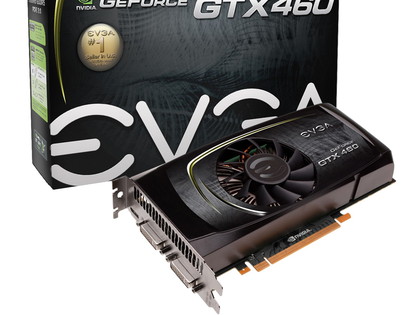
The GTX 460 comes with either 768MB or 1GB of GDDR5 onboard, and it's an interesting choice to make. There's very little price differential, but then, there's very little performance differential... until it comes to DX11 gaming.
With double the memory bandwidth and way more CUDA cores, it's quite some way ahead of its smaller brother, the GTS 450. It's capable of much greater throughput, and you feel the difference immediately.
You can happily expect around 25-30 per cent more pixel-shovelling right across the board, which is pretty impressive, and makes the GTS 450 hard to view with serious buyer's intent.
Read the full EVGA GeForce GTX 460 review
HIS Radeon HD 6870 - £210
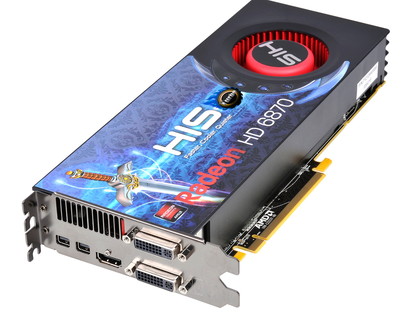
AMD's 6870 was always going to be something of a stop-gap between the 5-series and the new top-end 6-series. But it does bring some new functionality to the party, in the name of HD3D.
Get daily insight, inspiration and deals in your inbox
Sign up for breaking news, reviews, opinion, top tech deals, and more.
Yes, this is AMD's passive 3D technology, ladies and gentlemen. It's largely nascent at present, of course, but the card also supports HDMI 1.4a for 3D Blu-Ray displays.
Architecturally, this mainstream card is a cross between the 5830 and 5850. You get the full-fat 32 ROPs as found on the 5850, but with a core configuration of 1,120 stream processor, as found inside the 5830, and the card's smaller brother, the HD 6850.
Read the full HIS Radeon 6870 HD review
HIS Radeon HD 5850 - £200
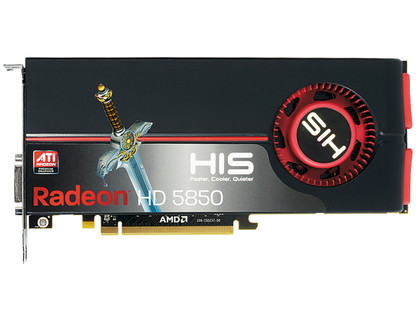
Have a scoot around the online retailers for the Radeon HD 5850, and you're not so much opening a can of worms as stripping naked, upending the can on your head, and running off down the streets with a hoot and a gibber, twig and berries flapping in the breeze.
Ranging from £150 to £250 for identical cards, the pricing is nothing short of crackers. Which speaks volumes about the unfortunate state of affairs for AMD's first-gen DX11 mid ranger. Nobody knows what it's really worth any more, and to be quite frank, that's nobody's fault but AMD's.
Read the full HIS Radeon HD 5850 review
MSI GeForce GTX 470 Twin Frozr II - £205
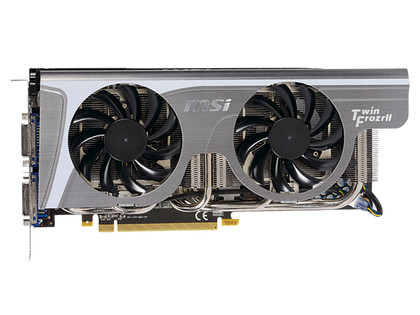
As with every generation of cards, the flagship sets sail before the hanky-waving crowds, and the slimmed down versions with slightly less capable GPUs follow in their wake.
The GTX 470 came hot on the heels of the GTX 480, and with only marginally reduced architecture. It first launched at £290, in what seemed like a direct attack on AMD's excellent HD 5870. That's proper, high-end, enthusiast pricing, and you'd expect pretty hefty performance for that kind of outlay.
But price cuts happen, and never more explosively than with the GTX 470. While you can plump for enhanced, 1.5GB versions with higher clockspeeds, this overclocked model from MSI offers sterling performance for just a shade over £200. Incredible!
Read the full MSI GeForce GTX 470 Twin Frozr II review
PNY GeForce GTS 450 1GB - £100
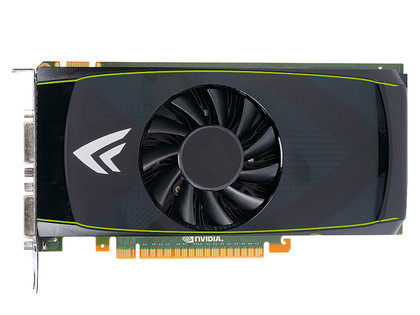
The GTS 450 offers mainstream gaming at an affordable pricepoint. This tiny powerhouse (well, it's still dual-width, but pleasingly short) is capable of feats beyond its £100 price tag.
What's more, in SLI, you'll see massive performance gains of 80 to 90 per cent, making the dual-card upgrade path a realistic and rewarding option for budget systems.
It bears architectural similarities to its bigger brother, the GTS 460, but with half the memory bandwidth and half the CUDA cores. What's impressive is that it doesn't offer half the performance in DX10 games, which it's perfectly happy with. Start throwing DX11 at it though, and it begins to run out of puff in fairly short order.
Read the full PNY GeForce GTS 450 1GB review
HIS Radeon HD 6850 - £140
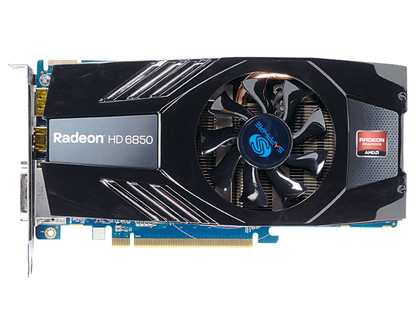
Take any card by either manufacturer and benchmark it next to its direct competitor from the other camp and there's at least one very clear conclusion to draw. Nvidia has the grunt, while AMD has the elegance.
But another factor soon becomes apparent. When DX11 is added to the mix, AMD's performance doesn't tail off quite so quickly at the higher resolutions, and it's a point the HD 6850 makes very well indeed.
This card represents a bit of an odd mixture. It seems to be built specifically to tackle DX11, and yet it still lacks the raw power to contend with its closest competitor in the price-range, the GTX 460 1GB, in DX10 applications. And of course, in DX11 games it outperforms the card it was designed to replace: AMD's own HD 5850.
Read the full HIS Radeon HD 6850 review
Sapphire Radeon HD 5750 - £85
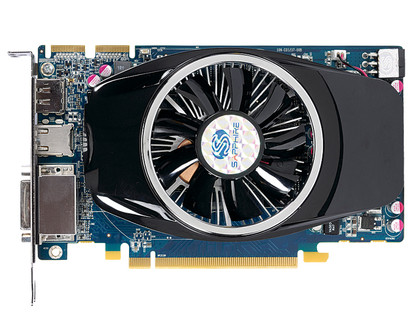
The HD 5750 is no a rampaging powerhouse. It can run games at 1,680 x1,050, but don't expect searing frame rates, especially when anti-aliasing and anisotropic filtering are on the cards.
Moreover, DX11 effects, such as Tessellation and Multi-thread Rendering, require the kind of resource budgets the 5750 simply can't raise. With its narrow memory bus and a GPU that pales in comparison to AMD's other offerings, it struggles in these tests.
Market changes mean that things have got a little better for the HD 5750, however. Just a month or so back, it was priced similarly to Nvidia's GTS 450, the raw grunt of which it simply can't match. It's come down a bit in price now though, and can be found for around £15 cheaper than the GTS 450, and its bigger brother, the HD 5770.
But still that £15 makes the difference between decent and average gaming at 1,680 x 1,050.
Read the full Sapphire Radeon HD 5750 review
XFX Radeon HD 5770 - £100

AMD's pokey little mid ranger, the HD 5770, has been around for some time now. AMD is in the process of refreshing its range with the new 6-series cards, so we have to ask: is there still a place in the world for this little fellow?
The answer is a resounding yes. At £100, the 5770 offers pretty decent value for money. And while this example from XFX trades HDMI for DisplayPort and a single DVI-D connection to keep the costs down, it's also a more elegant solution than most 5770s due to its single-slot nature and compact heatsink.
The 5770 always did run cool and quiet – so who needs a chunky lump of copper on there taking up space and weight? When a card is this cheap, the upgrade path that Crossfire represents is an option too. Priced to compete with Nvidia's GTS 450, can it match it in the performance stakes?
Read the full XFX Radeon HD 5770 review
Zotac GeForce GTX 460 1GB - £140
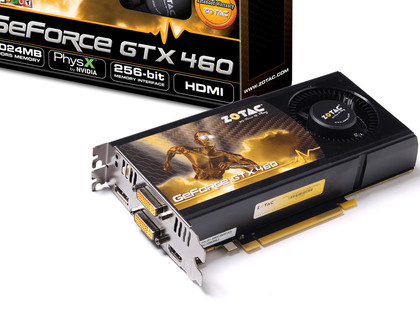
For just a few bob more than the vanilla GTX 460, you're 256MB of GDDR5 richer. The full 1GB version of the GTX 460 launched at a price-point which undercut its immediate Radeon-flavoured competition by a fair margin, and that situation has only got better for the card as the months have gone by.
It's a small dual-width beast that packs a hefty punch. Compared to the wheezing, overheating behemoths of yesteryear, such as ATI's infamously noisy 4870, it's positively gentlemanly.
It can get warm, but while the fan does scale up, the noise levels are quite acceptable. What's more, SLI (and the same is true of CrossFire) has come of age.
Two cards in tandem really do offer major performance gains. So much so that a pair of these will comfortably outperform Nvidia's own GTX 480 – and with a saving of £50 to £60. If you're looking for power now, and more power later, it should be a serious consideration.
Read the full Zotac GeForce GTX 460 1GB review
Zotac GeForce GT 430 Zone ED - £65
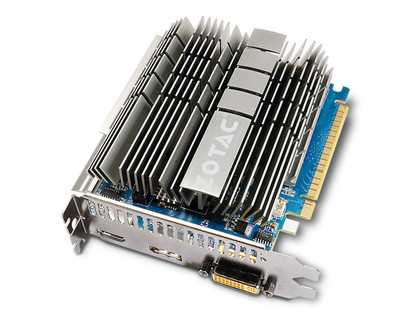
As timing goes, the GT 430's kind of sucked. While AMD had its low-end DX11 cards in the marketplace by February, it's taken Nvidia far longer to trim down its Fermi line of GPUs to pint-sized pricing, and performance to match.
The result is that this little fellow landed in October 2010, to very little fanfare. Understandably so, as this is no gamer's card. Its tiny stature tells most of the story. More at home in a media centre PC than a games rig, it boasts half the CUDA cores of its bigger brother the GTS 450, and a quarter of the ROPs.
Factor in a gigabyte of GDDR3 memory rather than the gaming standard GDDR5, and you've a recipe for low frame rates in today's high-end games –especially under the heavy demands of DX11.
Read the full Zotac GeForce GT 430 Zone ED review
Benchmark analysis
A quick scan through the benchmark tables on this page and it's fairly clear that this side of £200 that it's Nvidia that's literally holding all the cards. The Radeon HD 6870 makes a good fist of it, but is too close to the GTX 470 in price and not consistently in performance terms.
For the money the superlative GeForce GTX 460 1GB is quite simply unbeatable at the moment. The heavy tessellation benchmark in Heaven shows just how far ahead Nvidia's architecture is compared to the older single graphics engine and single tessellation unit that exists in the last generation of AMD's DirectX 11 GPUs.
The update in the new Cayman GPUs makes them far more competitive in DX11 terms, but for now they're still way above £200.
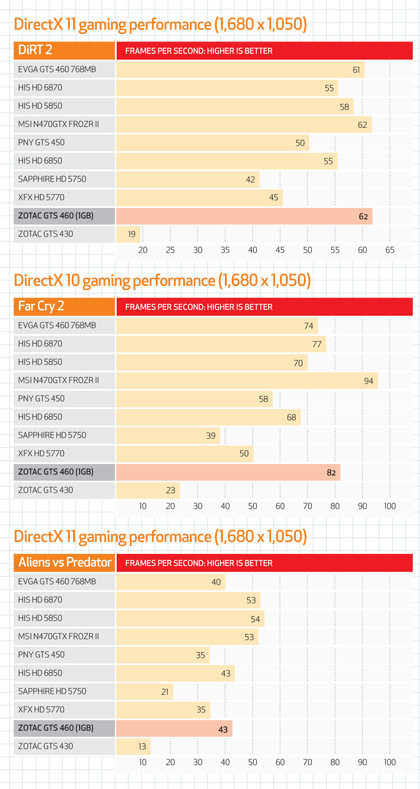
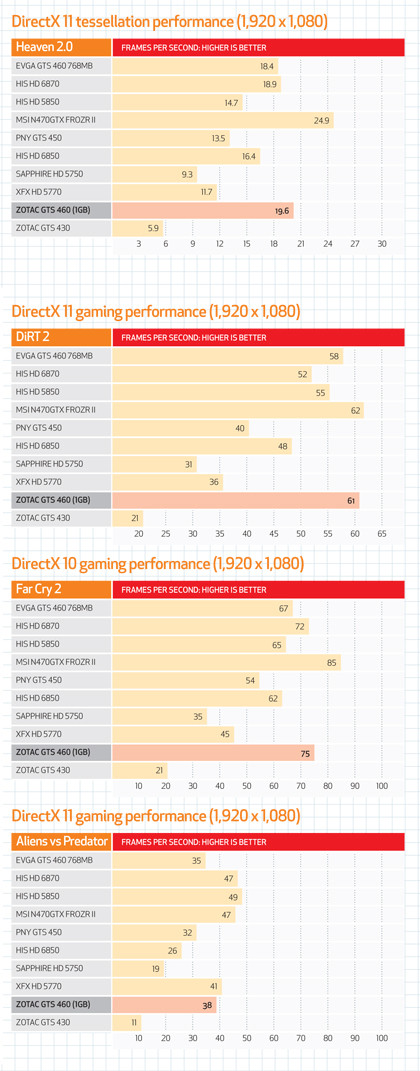
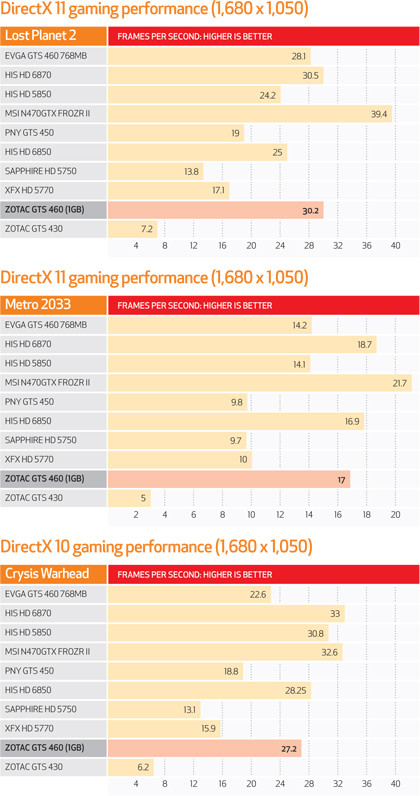
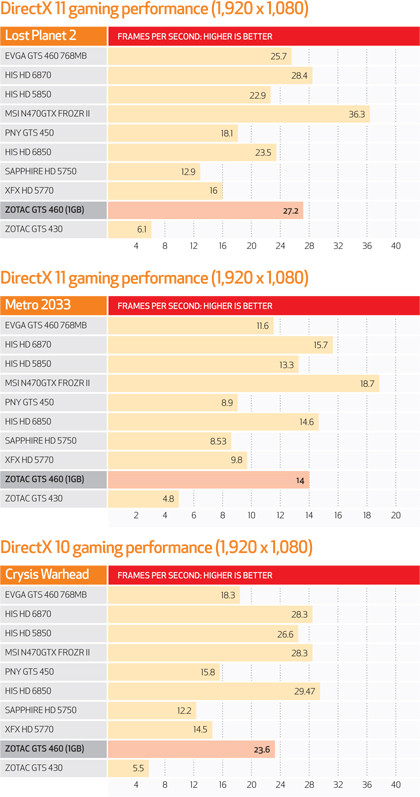
And the best budget DX11 card is...
There's a pitched battle going on in the mid-range cards at the moment, and a more confusing amount of cards than ever to choose from.
Two things have caused this: the switch to DirectX 11, and the rapid series of range refreshes from each manufacturer. What's important to note is that there are a few stand-out card examples at various price ranges which are head-and-shoulders above their peers.
So let's break it down into brackets. Which graphics card should you buy on specific budgets?
If you've £100 to spend on a card, there are two clear choices open to you: AMD's HD 5770 and Nvidia's GTS 450. They're both decent budget cards, and will serve you well at lower resolutions - from 1,280 x 1,024 to 1,680 x 1,050.
If you've up to £150 burning a hole in your pocket, then the two stand-out cards are Nvidia's GTX 460 1GB and AMD's HD 6850. The HD 6850 just edges it in DX11 games, but for considerably performance in DX10 and competitive performance in DX11, it simply has to be the GTX 460 1GB. It rocks the midrange at 1,680 x 1,050, and remains capable at 1,920 x 1,080.
And if you're prepared to spend up to £200, there really is only one choice: Nvidia's GTX 470. Originally a £290 high-end card, it's been subjected to an astounding series of price-cuts, and at just £205, the MSI model we tested offers incredible value for money. It offers blistering DX10 performance up to 1,920 x 1,080, and holds its own in DX11 games too. If you can muster the funds we absolutely recommend it.
-----------------------------------------------------------------------------------------------------
First published in PC Format Issue 249
Liked this? Then check out 15 best graphics cards in the world today
Sign up for TechRadar's free Weird Week in Tech newsletter
Get the oddest tech stories of the week, plus the most popular news and reviews delivered straight to your inbox. Sign up at http://www.techradar.com/register
Technology and cars. Increasingly the twain shall meet. Which is handy, because Jeremy (Twitter) is addicted to both. Long-time tech journalist, former editor of iCar magazine and incumbent car guru for T3 magazine, Jeremy reckons in-car technology is about to go thermonuclear. No, not exploding cars. That would be silly. And dangerous. But rather an explosive period of unprecedented innovation. Enjoy the ride.